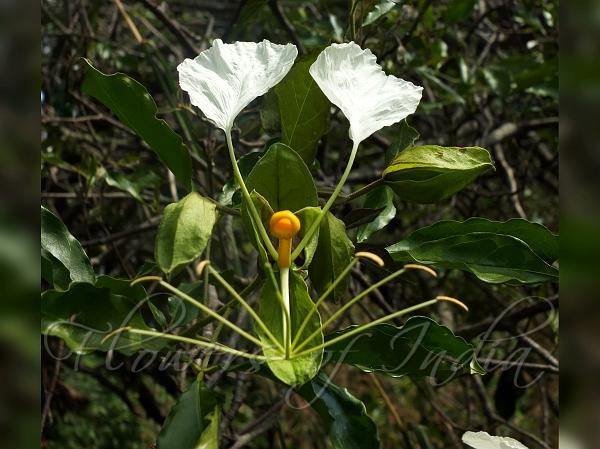|
| Three-Leaf Cadaba |
|

|

| File size | 663744 |
| Original date | 2/11/16 10:49 AM |
| Resolution | 2048 x 1536 |
| Flash | Flash did not fire, auto |
| Focal length | 11.6mm |
| Exposure time | 1/800s |
| Aperture | 5.0 |
| Focus Distance | |
| Metering Mode | Spot |
| Camera make | FUJIFILM |
| Camera model | X-S1 |
| Sensor type | OneChipColorArea |
|
|
|
|
Photo: |
Botanical name: Cadaba trifoliata Family: Capparaceae (Caper family)
Synonyms: Cadaba triphylla, Desmocarpus missionis
Synonyms: Cadaba triphylla, Desmocarpus missionis
Three-Leaf Cadaba is an unarmed branched shrub,
erect or climbing, 2-3 m high; stem white-tubercled; young parts
scabrous. Leaves are alternate, mostly 3-foliolate; leaf-stalks 1-4 cm
long, shorter than leaflets; leaflets elliptic, oblong-lanceshaped,
ovate-elliptic or obovate, wedge-shaped at base, tapering at tip, 4-10
x 1.5-5 cm, distinctly netveinedly nerved; leaflet-stalks 1.5-3 mm
long. Racemes corymbose, 4-10 flowered. Sepals 4; outer 2 ovate, 2-2.5
x 0.8-1 cm; inner 2 ellliptic, about 15 x 5 mm. Petals 2, nearly round,
3.5-5 x 2.5-3 cm, white or cream coloured, claw as long as limb. Disc
appendage spoon-shaped, toothed at tip, about 15 mm long, shorter than
claw, yellow. Androphore absent. Stamens 6 or 7, inserted in tnr middle
of gynophore, reflexed; filaments to 2.5 cm long. Gynophore 4-5 cm
long. Ovary linear, 7-8 x about 1 mm. Fruits round, 8-10 cm x 6-8 mm,
black; seeds many, kidney-shaped, about 3.5 x 3 mm, black. is endemics
to Peninsular India. Flowering: October-November.
Medicinal uses: Leaves are used as medicine
for eczema, intestinal worms, body pain and beetle sting. Bark is used
as nervine tonic.
Leaves are used as medicine
for eczema, intestinal worms, body pain and beetle sting. Bark is used
as nervine tonic.
Medicinal uses:
 Leaves are used as medicine
for eczema, intestinal worms, body pain and beetle sting. Bark is used
as nervine tonic.
Leaves are used as medicine
for eczema, intestinal worms, body pain and beetle sting. Bark is used
as nervine tonic. | Identification credit: Siddarth Machado | Photographed in Kalakkad Mundanthurai Tiger Reserve, Tamil Nadu. |
• Is this flower misidentified? If yes,